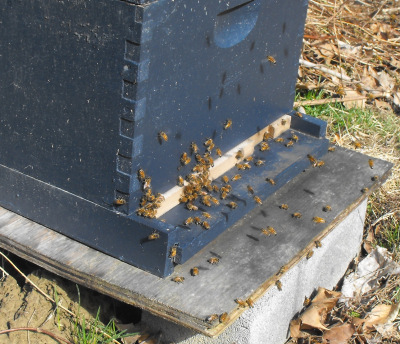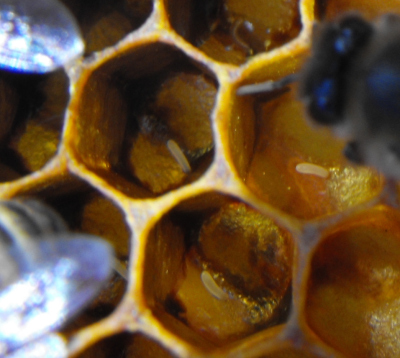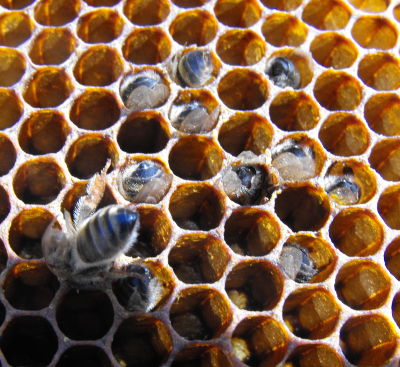
March hive activity
 When
the sun came out Thursday morning, so did
the honeybees. For the first time this year, they seemed to be
deep into a pollen
or nectar flow of
some sort --- there were aerial
traffic jams as the bees piled up, trying to make it through the little
hole in the entrance
reducer.
Honestly, I'm not sure what their
primary food is right now, since I've seen them on the crocuses (more
in the embedded video) and on the tiny speedwell, dead nettle, and
chickweed flowers in the yard. I suspect there may be something
much larger blooming out in the woods to account for this much traffic
--- maybe those swollen elm or hazel buds have burst open?
When
the sun came out Thursday morning, so did
the honeybees. For the first time this year, they seemed to be
deep into a pollen
or nectar flow of
some sort --- there were aerial
traffic jams as the bees piled up, trying to make it through the little
hole in the entrance
reducer.
Honestly, I'm not sure what their
primary food is right now, since I've seen them on the crocuses (more
in the embedded video) and on the tiny speedwell, dead nettle, and
chickweed flowers in the yard. I suspect there may be something
much larger blooming out in the woods to account for this much traffic
--- maybe those swollen elm or hazel buds have burst open?
 So much for the outside of
the hive --- what's
going on inside? Once the day was thoroughly warm, I went ahead
and opened up the hives to see how the end of winter was treating the
colonies. I found tiny white eggs, grub-liked larvae, and capped
cells of pupae in two of the hives, along with scads of leftover
honey. I took out the entrance reducers and popped a new super on
each hive just in case the bees get really industrious before I check
back.
So much for the outside of
the hive --- what's
going on inside? Once the day was thoroughly warm, I went ahead
and opened up the hives to see how the end of winter was treating the
colonies. I found tiny white eggs, grub-liked larvae, and capped
cells of pupae in two of the hives, along with scads of leftover
honey. I took out the entrance reducers and popped a new super on
each hive just in case the bees get really industrious before I check
back.
The queens are clearly
just starting to lay their eggs, but I saw a
troublesome sign in one hive. The bees had extended three of the
larvae's cells out beyond the comb's normal face --- it looks to my
untrained eye like they're thinking of building queen cells. That
would mean that I let the hive get too congested with honey and the
bees are thinking of swarming. I'll check on them again next week
and, if necessary, split the hive in two to keep all of the bees under
domestication.
 I
also found a tiny cluster of eleven starved
bees. The poor things were face down in adjacent cells, searching
for honey. I've read that little
starvation clusters like this happen when a sudden cold snap strands
some of the bees outside the main cluster. They can't find the
frames of honey, even though food can be quite nearby. Still, a
death toll of less than a dozen bees is not bad since most beekeepers
lose a
third of their hives over the winter. Our chemical-free hives are
still happy and healthy.
I
also found a tiny cluster of eleven starved
bees. The poor things were face down in adjacent cells, searching
for honey. I've read that little
starvation clusters like this happen when a sudden cold snap strands
some of the bees outside the main cluster. They can't find the
frames of honey, even though food can be quite nearby. Still, a
death toll of less than a dozen bees is not bad since most beekeepers
lose a
third of their hives over the winter. Our chemical-free hives are
still happy and healthy.
Want more in-depth information? Browse through our books.
Or explore more posts by date or by subject.
About us: Anna Hess and Mark Hamilton spent over a decade living self-sufficiently in the mountains of Virginia before moving north to start over from scratch in the foothills of Ohio. They've experimented with permaculture, no-till gardening, trailersteading, home-based microbusinesses and much more, writing about their adventures in both blogs and books.
Want to be notified when new comments are posted on this page? Click on the RSS button after you add a comment to subscribe to the comment feed, or simply check the box beside "email replies to me" while writing your comment.
